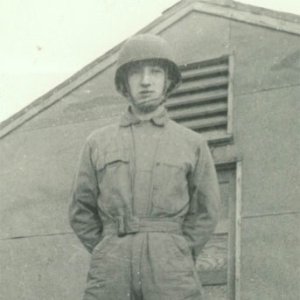- SURNAME
Weiss
- FORENAME
Herbert
- UNIT
501 Parachute Infantry Regiment (Company B)
- RANK
Private
- NUMBER
36547711
- DATE OF DEATH
11th June 1944
- AGE
- GRAVESITE
- ADDITIONAL INFORMATION
from Detroit,Wayne County,Michigan
KIA Graignes,Normandy
Received courtesy of Brian Dawson
The following is recent correspondence i received from Dr. A. Weiss, brother of PFC H. Weiss.
Citation:
In 1984 on the occasion of the 40th anniversary of the D-Day landings on Omaha and Utah beaches, the Detroit newspapers had a story about Sgt. George Koskimaki of the 101st Airborne who served as a radioman for General Maxwell Taylor in Normandy and Holland.
I contacted Koskimaki who lived in the western suburbs of Detroit, either in Livonia or Northville. He had written a book entitled "D-Day with the Screaming Eagles" and said it was available for sale at the Finnish Cultural Center on 8 Mile Road in Livonia. I bought the book. Koskimaki was originally from Ishpeming in the Upper Peninsula of Michigan, the son of Finnish immigrants and attended Northern Michigan University, becoming a school teacher. He later received a Master's Degree from Wayne State University. Koskimaki put me in touch with Frank Juliano who lived on Staten Island in the NYC area. I contacted Juliano and found out the following: Herbert was on the same plane as Juliano and Capt. Loyal Bogard, their Company B commander. Capt. Bogard injured his leg when struck by flak in the plane, but insisted on jumping with the guys. Juliano said he joined the 501st later and was not part of the original formation of the 501st back in the States. But, he got to know Herbert well and said that he joined up with Herbert and Capt. Bogard after the jump into Normandy with the rest of their 'stick'. Their platoon was dropped over the marshes near Graignes, six miles southeast of Carentan. Juliano said he remained in the marshes and joined up with the rest of his stick in the daylight hours. They joined a larger group of men of the 82nd Division in the town of Graignes. At sometime later, he lost contact with Herbert and doesn't exactly know what happened to Herbert after they were overrun by a German Panzer Unit. When they run out of ammo, most of the troopers snuck away in the night through the marshes helped by the local French people. The wounded who could not be moved were left in the church with the Battalion surgeon. Juliano said that Herbert was not part of this group who were killed - either shot or bayoneted - by the Germans. Juliano hid in a barn and remained their assisted by the French farming family until the Americans came up from the beaches and retook the area. He said that date was July 12, 1944. So, apparently he safely avoided detection by the Germans for about a month. So the question remains - was Herbert KIA on June 11th as stated in the French story when the unit was overrun by the German Panzer unit? I guess it doesn't really matter.
For your information, the average paratrooper carried from 125-150 pounds of gear on his person, including 2 parachutes. The normal dropping speed was 110-120 mph. At that speed, the trooper retained his gear. If the plane was at a speed of 150-180 mph when dropped (pilots were ordered not to speed up), part of the vital gear got to the ground long before the trooper set foot in France. Many troopers reported that the planes sped up before the drop because of flak.
The book, "D-Day with the Screaming Eagles" is a compendium of actions of individuals and groups of the 101st Airborne Division that Koskimaki interviewed in writing the book.
D-Day assignment:
Herbert's outfit, Baker Company of the 501st Parachute Regiment, was assigned to Drop Zone "D" in Normandy - near St. Come-du-Mont and the Douve River. The 501st was assigned to: (1) seize the LaBarquette Locks; (2) capture the high ground around St. Come-du-Mont;
(3) capture or destroy the highway bridges leading to Carentan. Unfortunately, Herbert's plane dropped his stick of 18 men 6 miles SE of Carentan. Col. Johnson, the Regimental commander, and his headquarters group jumped with the 1st Battalion in a serial consisting of 45 planes. Only 18 dropped their sticks near drop zone "D". The rest were scattered and some like Herbert's plane got the green light several miles south of Carentan.
The Division strength of the 101st was 14,200 men. And, 6,600 parachuted into France in the early hours of D-Day.
Marilyn and I did visit the Normandy beaches, the American (Utah and Omaha) and the British/Canadian beaches as well. We also drove to Graignes and visited the chapel near the town cemetery which contained the plaque listing those who fell. Very moving. Hope this writing helps fill in some of the gaps in the story.
DATE OF DEATH:
11-Jun-1944
Last edited by a moderator:




